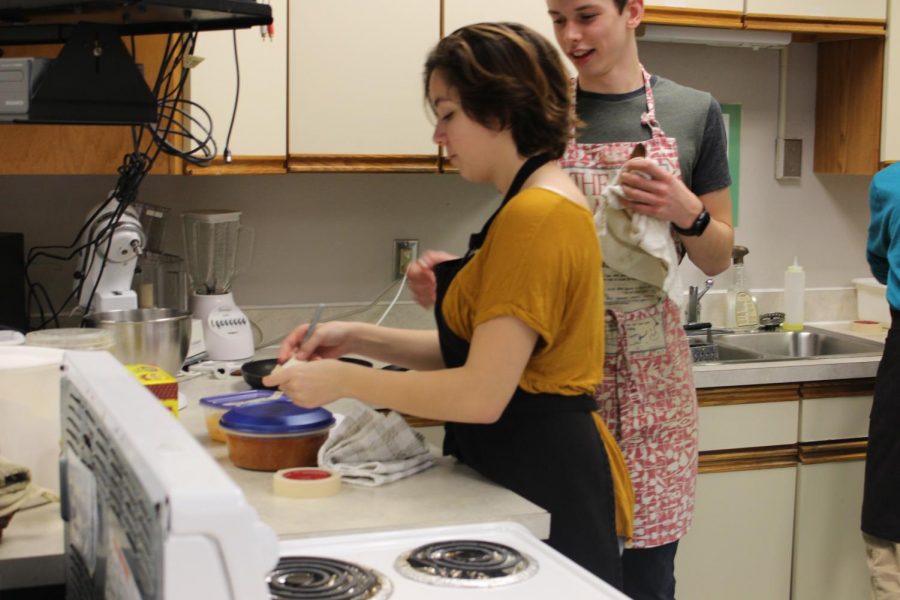Students Compete in Iron Chef
January 21, 2018
Despite limited planning time and other issues as a result of the recent delays and closings this week, the Iron Chef Competition was still a success.
For the past two or three years, foods teacher Martha Sandusky has been holding the Iron Chef Competition at the end of the marking period.
The winners of the competition automatically get a 100 percent in the class, as well as being exempt from the final.
There are six total groups of students: three competing in the dessert category and the other three are making main dishes. Each group gets one period to plan and prep their dishes, and then the next period they have to make final touches and plate their dish.
The final plates are then judged anonymously based on appearance, taste and difficulty, and they are ranked first, second, and third.
Some examples of the dishes include: tiramisu, ombre cake, strawberry parfait, chocolate honey-pots, fruit tarts, jello bowls, spaghetti tacos, chicken quesadillas, chicken kabobs, kimchi, avocado quesadillas, thai chicken enchiladas and baked stuffed tomatoes.
One reason that Sandusky holds the Iron Chef Competition is to give students a chance to learn how to work together in groups.
“I just thought it would be a fun way to end the course and give them a chance to show off what they can do as a group. They’re learning how to work together as a group all through the year, and it’s a group project, so they have to put it all together and work together to do it. It’s like the culminating activity for the class,” said Sandusky. “So it can show me that they learned to work together, they can take a recipe and follow it through to completion, and the big part of Iron Chef is making it look good and plating it. Which is something that they don’t usually do in the other labs, they don’t particularly care what it looks like, but this one for judging they have to make it look good.”
Freshman Alyssa Broderick, whose group won the dessert category, feels that she has taken away the lesson that Sandusky intends of working in groups.
“Our group learned a lot about the importance of teamwork and other baking techniques we had not known beforehand,” said Broderick.
Broderick’s group made a fruit tart; they were not rushed for time at all, and had almost no problems.
“I was pretty confident about our dish because the recipe seemed easy to make and the final presentation was ultimately our choice. The day of the judging we had about 15 minutes to decorate the tartes with fruits, jam, and mint leaves, the final product was beautiful and we were all pretty confident with our dish,” said Broderick. “Everything went expected despite the crust crumbling upon taking the first tart out of the dish. Luckily, we made more than enough fruit tarts and decided to just leave them in their pans to avoid any more breaking.”
Sandusky was pleased with the student’s performances despite the time constraints.
“Considering that we had no planning time, and they only had a half hour the first day because of the delay, they did really well, I was impressed. They came through, they finished, they all cleaned up on time, and I was pleased with how it turned out. And some of the desserts, the teachers were impressed with,” said Sandusky.
History teacher Andrew Warren, a first time Iron Chef judge, enjoyed tasting the dishes and was impressed with appearance.
“This was my first time judging for the competition. I’m just looking for opportunities to see what other teachers are doing in their classes, and Mrs. Sandusky had sent out an email for volunteers and I thought it would be a fun experience,” said Warren. “I look forward to hopefully judging more Iron Chef Competitions in the future,” said Warren. “I was extremely impressed with how much hard work must have went in in the part of the students to create desserts that had really nice appearance and taste as well.”
Sandusky thinks that the most important skill the students take away from Iron Chef is learning to not only care about taste, but also appearance.
“This year was so difficult because of the stress of the planning. I think they get a sense of accomplishment, because they actually have to do something, it has to be judged, and it has to look good. So, I can see them struggling to make each plate look the way it should, and I think appearance in food is really a big factor when you go to a restaurant and you see what it looks like, that’s a big factor in whether you like the dish or not. So I think the plating is probably the biggest learning that they get from this, and making it look good for others, not just for themselves,” said Sandusky.





